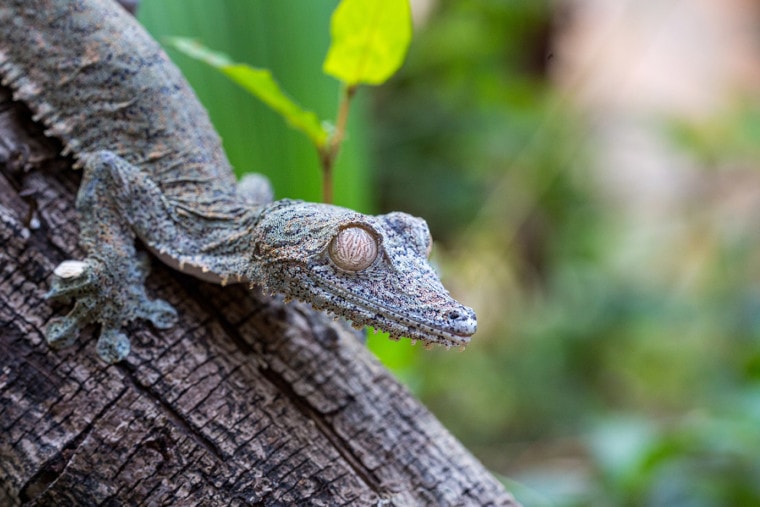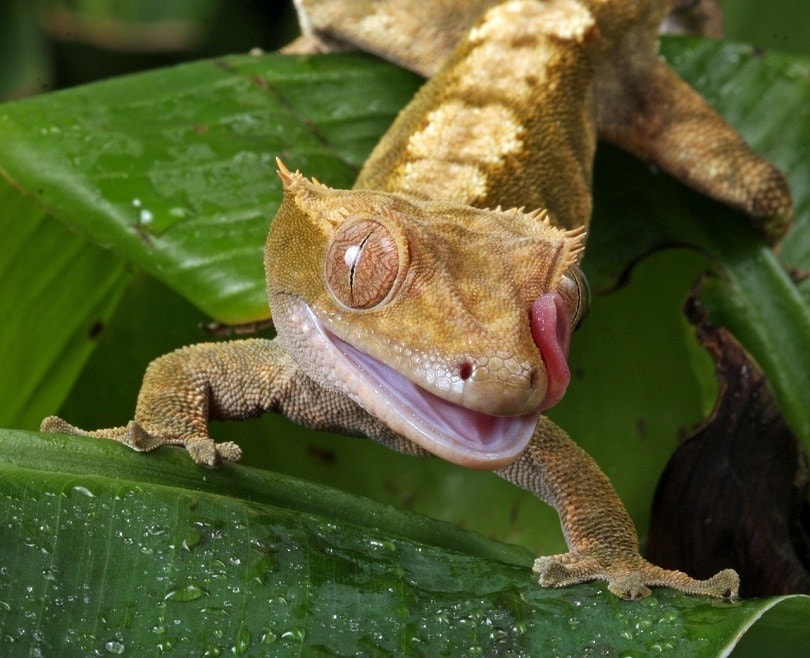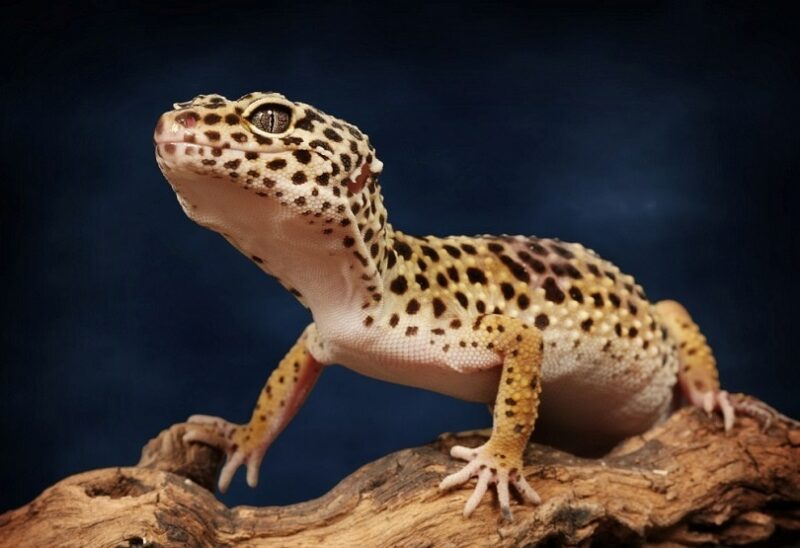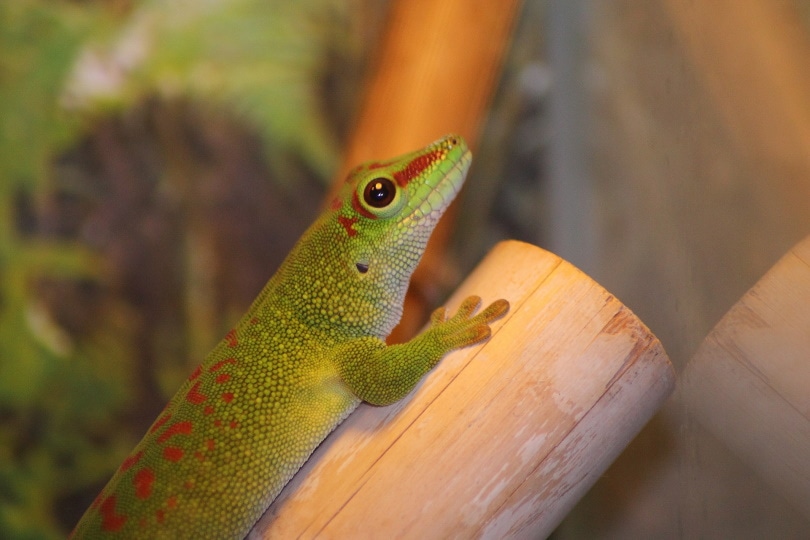
Isn’t it amazing how creatures evolve to fit their surroundings? The incredibly fascinating giant leaf-tailed gecko is a stunning specimen, fitting its name to a tee. Their tails mimic a leaf to protect themselves from predators in the wild.
Their boggling looks might spark your curiosity—but don’t get too excited. If you’re a newbie, these are not the reptiles for you. Let’s jump into their care requirements so you can figure out if this gecko should be added to your home habitat.

Quick Facts about Giant Leaf-Tailed Gecko
| Species Name: | Uroplatus phantasticus |
| Family: | Gecko |
| Care Level: | Difficult |
| Temperature: | 75 to 82 degrees Fahrenheit |
| Temperament: | Calm, docile |
| Color Form: | Mottled brown, tan, or orange |
| Lifespan: | 2 to 10 years |
| Size: | 10 to 12 inches |
| Diet: | Carnivorous |
| Minimum Tank Size: | 18” x 18” x 36” |
| Tank Setup: | Foliage, soft soil, perches |
| Compatibility: | Experienced owners |
Giant Leaf-Tailed Gecko Overview
The giant leaf-tailed gecko, formally known as the Uroplatus phantasticus, looks like something out of a movie. These breathtaking scientific anomalies hail from Madagascar—so it’s no wonder they have to adapt to protect themselves in an extreme tropical climate.
These shy lizards spend most of their time in foliage, camouflaging themselves to miss the eyes of lurking predators and hide from potential prey. But over the years, they started to become a pretty hot commodity in the pet trade industry.
The giant leaf-tailed gecko has picked up many nicknames along the way, including:
Due to the very particular housing and handling requirements of the leaf-tail, these guys are best for experienced owners only.

How Much Do Giant Leaf-Tailed Geckos Cost?
Giant leaf-tailed geckos are relatively rare in terms of gecko species—and their price reflects that. Not only are they hard to find, but they also have all sorts of attractive genetic traits that make certain ones more desirable over others.
If you buy from a breeder, you can expect to pay between $250 to $1,000. The total cost will depend on the specific markings and traits that show up.
Typical Behavior & Temperament
Leaf-tails are pretty particular when it comes to everyday care. Because they spend so much time in stillness to ward off predators, they are stressed, startled, or panicked if they are handled.
If you’re looking for a lizard that you can place on your shirt for an hour during TV time—this isn’t the one. These guys don’t like to be held, especially if they are wild-caught. They become stressed out very quickly.
For the most part, you should embrace a ‘look but don’t touch’ mentality. These lizards can be jumpy, skittish, and fast. A giant leaf-tailed gecko can quickly get away from you, too. And in case you haven’t picked up on it—they’re master hide and seekers.
Because of the unique care involved with owning a leaf-tail, only experienced owners should sign up for the job. They can be very rewarding to own, but there is too much room for error in novice situations.

Appearance & Varieties
The giant leaf-tailed gecko has a look all its own. It might be one of the most intriguing geckos in the species. They have a triangular-shaped head with flat tails that mimic leaves—including veins and color.
Leaf-tails are dimorphic, meaning you can visually tell the difference between males and females. Females have leaf-like tails that look like a healthy plant, whereas males look dried or crinkled.
Males also have a hemipenal bulge that develops around 6 months old.

How to Take Care of Giant Leaf-Tailed Gecko
If you like what you’ve heard so far, next comes the topic of care. The habitat and diet you provide for your leaf-tail sets the foundational blocks necessary for a healthy life.
Habitat, Tank Conditions & Setup
Enclosure
Your leaf-tailed geckos can live together, so the enclosure size will vary depending on how many you own.
A singular leaf-tail should have an 18” x 18” x 36” enclosure. You should increase the size of the habitat with each newcomer by 6 inches.
Substrate
Leaf-tails need moist, soft soil as a substrate. Many use peat or sphagnum mosses, as they can hold moisture without becoming messy.

Temperature
When it comes to the temperature, leaf-tails need warmth that mimics their natural environment. Tropical, these geckos need low basking temperatures of up to 84 degrees Fahrenheit.
The central part of the enclosure should range between 68 to 75 degrees Fahrenheit but drop to 62 in the night.
Humidity
Your gecko’s hydrometer should always read between 70% to 85% humidity. These creatures require moisture for their skin health and wellbeing.
Lighting
Lighting should mirror natural sleep/wake cycles in nature. A good rule of thumb is to provide UV light 12 hours per day.
Do Giant Leaf-Tailed Geckos Get Along with Other Pets?
Unlike some other species, leaf-tails do fine with other leaf-tails. You can have them in pairs or trios with no issues. They are usually very docile, but they can be aggressive in male pairs. So, be mindful of combinations and monitor how well they get along.

What to Feed Your Giant Leaf-Tailed Gecko
Giant leaf-tailed geckos require a very special and strict diet regimen. These are predatory creatures, eating lots of invertebrates and insects.
Some of the most common food items for your gecko include:
Note: You should never feed your leaf-tail wild insects. There is no way to be sure these insects are safe to eat, as they can carry parasites and bacteria that might make your gecko sick.
Keeping Your Giant Leaf-Tailed Healthy
If you keep feeding schedules on point and make sure they have a suitable environment, you should have a healthy gecko. However, there are some things in the health-related department you need to be familiar with.
First, before you bring home your leaf tail, you need to find an exotic vet in your area with experience in geckos. It’s important to schedule vet care at least once per year to make sure your leaf-tail is in good shape.

Common Issues for Giant Leaf-Tailed Geckos
These geckos can be a little finicky sometimes, so they are pretty sensitive. It would help if you were mindful of any behavioral or physical changes in your leaf tail.
Frequent health issues for giant leaf-tailed geckos include:
Breeding
If breeding giant leaf-tailed geckos, it’s important to know that they can be unreliable breeders. They are sensitive and often lay duds. For this reason, among others, you should only try breeding this species if you are highly experienced.
Since leaf tails are so thin, noticing a gravid female is relatively easy—as they expand outwardly. Make sure the female has a place to store the eggs. It should be moist but not damp moss soil.
Males should be separated from females once they are noticeably carrying eggs. In groups, males can become aggressive if housed together during this time.
Eggs typically hatch between 35 and 85 days.

Are Giant Leaf-Tailed Geckos Suitable for You?
Even though the giant leaf-tailed geckos are for experienced owners only, they can be extremely rewarding pets to keep. Make sure to research any remaining questions you have about this species thoroughly.
Also, make sure you check to see if you have a licensed exotic vet nearby for regular visits and emergencies.
Featured Image Credit: Petri Lopia, Shutterstock








